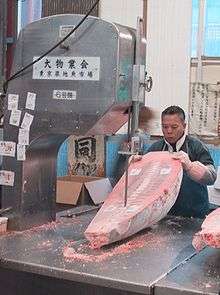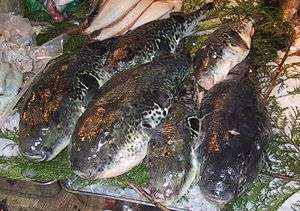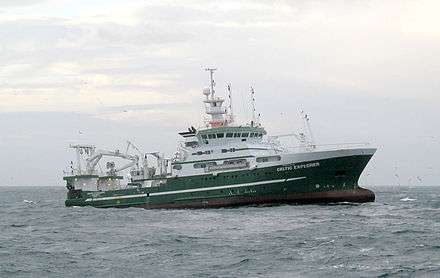Tsukiji fish market

The Tsukiji Market (築地市場 Tsukiji shijō), supervised by the Tokyo Metropolitan Central Wholesale Market (東京都中央卸売市場 Tōkyō-to Chūō Oroshiuri Shijō) of the Tokyo Metropolitan Bureau of Industrial and Labor Affairs, is the biggest wholesale fish and seafood market in the world and also one of the largest wholesale food markets of any kind.
The market is located in Tsukiji in central Tokyo, between the Sumida River and the upmarket Ginza shopping district. While the inner wholesale market has restricted access to visitors, the outer retail market, restaurants and associated restaurant supply stores remain a major tourist attraction for both domestic and overseas visitors.[1][2]
Location

The market is located near the Tsukijishijō Station on the Toei Ōedo Line and Tsukiji Station on the Tokyo Metro Hibiya Line. There are two distinct sections of the market as a whole. The "inner market" (jōnai-shijō) is the licensed wholesale market, where approximately 900 licensed wholesale dealers operate small stalls and where the auctions and most of the processing of the fish take place. The "outer market" (jōgai-shijō) is a mixture of wholesale and retail shops that sell Japanese kitchen tools, restaurant supplies, groceries, and seafood, and many restaurants, especially sushi restaurants. Most of the shops in the outer market close by the early afternoon, and in the inner market even earlier.
Economics
The market handles more than 400 different types of seafood from cheap seaweed to the most expensive caviar, and from tiny sardines to 300 kg tuna and controversial whale species.[3] Overall, more than 700,000 metric tons of seafood are handled every year at the three seafood markets in Tokyo, with a total value in excess of 600 billion yen (approximately 5.9 billion US dollars on November 24, 2013). The number of registered employees as of 25 January 2010 varies from 60,000 to 65,000, including wholesalers, accountants, auctioneers, company officials, and distributors.
Operations
The market opens most mornings (except Sundays, holidays and some Wednesdays) at 3:00 a.m. with the arrival of the products by ship, truck and plane from all over the world. Particularly impressive is the unloading of tons of frozen tuna. The auction houses (wholesalers known in Japanese as oroshi gyōsha) then estimate the value and prepare the incoming products for the auctions. The buyers (licensed to participate in the auctions) also inspect the fish to estimate which fish they would like to bid for and at which price.
The auctions start around 5:20 a.m. Bidding can only be done by licensed participants. These bidders include intermediate wholesalers (nakaoroshi gyōsha) who operate stalls in the marketplace and other licensed buyers who are agents for restaurants, food processing companies, and large retailers.
The auctions usually end around 10:00 a.m. Afterward, the purchased fish is either loaded onto trucks to be shipped to the next destination or on small carts and moved to the many shops inside the market. There the shop owners cut and prepare the products for retail. In case of large fish, for example tuna and swordfish, cutting and preparation is elaborate. Frozen tuna and swordfish are often cut with large band saws, and fresh tuna is carved with extremely long knives (some well over a meter in length) called oroshi-hōchō, maguro-bōchō, or hanchō-hōchō.
 Vendors display the morning's catch at the market at 4 a.m.
Vendors display the morning's catch at the market at 4 a.m.- End of the fresh tuna auction at Tsukiji
 A tray of six Takifugu rubripes on ice for sale at Tsukiji
A tray of six Takifugu rubripes on ice for sale at Tsukiji Tuna auction at Tsukiji
Tuna auction at Tsukiji Fishermen cutting fish at Tsukiji
Fishermen cutting fish at Tsukiji Fishermen cutting tuna at Tsukiji
Fishermen cutting tuna at Tsukiji
The market is the busiest between 5:30 and 8:00 a.m., and the activity declines significantly afterward. Many shops start to close around 11:00 a.m., and the market closes for cleaning around 1:00 p.m. Tourists may visit the market daily between 5 a.m. and 6:15 a.m. and watch the proceedings from a designated area,[4] except during periods when it is closed to the public.
Because of an increase in sightseers and the associated problems they cause, the market had banned all tourists from the tuna auctions on several occasions, including from 15 December 2008 through 17 January 2009,[5] 10 December 2009 through 23 January 2010,[6] and 8 April 2010 through 10 May 2010.[7] After the latest ban that ended in May 2010, the tuna auctions have been re-opened to the public with a maximum limit of 120 visitors per day on a first-come, first-served basis.[8][9] Visitor entry into the interior wholesale markets is prohibited until after 9 AM.[10] Due to the March 2011 earthquakes all tourists were banned from viewing the tuna auctions till 26 July 2011, from which date it was reopened.[11]
Inspectors from the Tokyo Metropolitan Government supervise activities in the market to enforce the Food Hygiene Law.
History

The first market in Tokyo was established by Tokugawa Ieyasu during the Edo period to provide food for Edo castle (nowadays Tokyo). Tokugawa Ieyasu invited fishermen from Tsukuda, Osaka to Edo to provide fish for the castle. Fish not bought by the castle was sold near the Nihonbashi bridge, at a market called uogashi (literally, "fish quay") which was one of many specialized wholesale markets that lined the canals of Edo (as Tokyo was known until the 1870s).
In August 1918, following the so-called "Rice Riots" (Kome Sōdō), which broke out in over 100 cities and towns in protest against food shortages and the speculative practices of wholesalers, the Japanese government was forced to create new institutions for the distribution of foodstuffs, especially in urban areas. A Central Wholesale Market Law was established in March 1923.
The Great Kantō earthquake on September 1, 1923, devastated much of central Tokyo, including the Nihonbashi fish market. In the aftermath of the earthquake, the market was relocated to the Tsukiji district and, after the construction of a modern market facility was completed in 1935, the fish market began operations under the provisions of the 1923 Central Wholesale Market Law. Three major markets in Tsukiji, Kanda, and Koto began operating in 1935. Smaller branch markets were established in Ebara, Toshima, and Adachi, and elsewhere. At present, the Tokyo Metropolitan Government's system of wholesale markets includes more than a dozen major and branch markets, handling seafood, produce, meat, and cut flowers.
Building
Following the 1923 Great Kantō earthquake architects and engineers from the Architectural Section of Tokyo Municipal Government were sent to Europe and America to do research for the new market. However, because of the sheer size of the market and the number of items traded they were forced to come up with their own unique design. The quarter circular shape allowed easier access and handling for freight trains and the steel structure above allowed a wide, continuous space free from columns and subdivisions.[12]
Planned relocation to Toyosu
The Tsukiji fish market occupies valuable real estate close to the center of the city. Former Tokyo Governor Shintaro Ishihara repeatedly called for moving the market to Toyosu, Koto.[13] The long-anticipated move to the new market was scheduled to take place in November 2016, in preparation for the 2020 Tokyo Summer Olympics,[14] but on August 31, 2016, the move was postponed.[15] The new location has been criticized for being heavily polluted and in need of cleanup.[16] There are plans to retain a retail market, roughly a quarter of the current operation, in Tsukiji.[17] The remaining area of the market will be redeveloped.[18] During the construction of the new site concerns remained about the safety of the site.[19]
In popular media
- The Tsukiji fish market was featured on the July 8, 2008 episode of the American reality show I Survived a Japanese Game Show. In the episode, the winning team (the Yellow Penguins) received a reward in the form of a VIP tour of the fish market.
- In the 2011 documentary film Jiro Dreams of Sushi, the market is featured and discussed as it relates to Jiro Ono's life profession as a world-renowned sushi chef.[20]
- The market is featured in the music video for the 2014 single "Rather Be" by the British band Clean Bandit.
- The Japanese culture and lifestyle television show Begin Japanology aired on NHK World featured a full episode on Tsukiji fish market in 2008.
- The travel show Globe Trekker featured the Tsukiji market during host Ian Wright's trip to Tokyo. It showed a fish auction, then a short tour through its surroundings and finished with Wright eating sushi in a nearby sushi parlor.
Notes
- ↑ McCurry, Justin (5 December 2008). "Tokyo catch: Fish market bars tourists". The Guardian. Retrieved 17 February 2009.
- ↑ Goldberg, Lina (24 February 2013). "10 of the world's best fresh markets". CNN Travel. Retrieved 24 February 2013.
- ↑ Heller, Peter (2006) "The Whale Warriors: Whaling in the Antarctic Seas" National Geographic Adventure
- ↑ BBC NEWS: "Tokyo scales back fish tourists" (28 March 2008). Retrieved on 3 December 2008.
- ↑ "Too many foreigners forces ban on tourists to Tsukiji fish market," Mainichi Daily News, December 3, 2008. Retrieved on 3 December 2008.
- ↑ Nikkei Shimbun, November 24, 2009 (in Japanese).
- ↑ "Tsukiji to temporarily close tuna auction area to the public". Mainichi Daily News. 2010-04-07. Archived from the original on April 10, 2010. Retrieved 2010-04-07.
- ↑ "Tsukiji tuna auction site reopens to visitors". Mainichi Daily News. 2010-05-11. Archived from the original on May 12, 2010. Retrieved 2010-05-13.
- ↑ "Tsukiji Today",Tsukiji Sushi Workshop. Retrieved 29 October 2014
- ↑ "築地市場マグロ卸売場における見学方法の変更について [Japanese]" (Press release). Metropolitan Central Wholesale Market. 2010-04-30. Retrieved 2010-05-13.
- ↑ "Tokyo Travel: Tsukiji Fish Market". Japan-guide.com. Retrieved 2014-02-07.
- ↑ 'Spring 2005, "Do_co,mo.mo Japan: the 100 selection", The Japan Architect, No57, p54
- ↑ Fukada, Takahiro (2010-10-23). "Tsukiji to relocate to Toyosu: Ishihara". The Japan Times. Retrieved 2014-02-07.
- ↑ "Tsukiji fish market to get new home in late 2016 as Olympics beckon". Asahi Shimbun. 18 December 2014. Retrieved 11 April 2015.
- ↑ "Smelling something fishy, Koike puts Tsukiji fish market relocation on ice". Japan Times. 2016-08-31. Retrieved 2016-09-22.
- ↑ "Moving Tokyo's Fish Market: Tsukiji In Trouble | Consumers Union of Japan". Nishoren.org. 2009-03-25. Retrieved 2014-02-07.
- ↑ Takei, Hiroyuki (9 February 2012). "New fresh fish market planned when Tsukiji market moves". Asahi Shimbun. Retrieved 2014-02-07.
- ↑ Ito, Masami, "Tsukiji countdown: clock ticking on famed fish market", Japan Times, 1 November 2015, p. 14
- ↑ Osumi, Magdalena Tsukiji workers demand answers over toxic soil at new site Feb 22, 2016 Japan Times Retrieved February 23, 2016
- ↑ Michael, Chris (11 January 2013). "Jiro: Dreams of Sushi: a film about fish, fine-dining and fatherhood".
References
- Bestor, Theodore C. (2004), Tsukiji: The Fish Market at the Center of the World, Berkeley: University of California Press, ISBN 0-520-22024-2
- " Tokyo's Tsukiji Fish Market Threatened By Globalization," Bloomberg News, September 28, 2005.
- Documentary Film 'The Cost of Sushi; Emptying the Seas' (2012) by director Pedro Barbadillo.
External links
| Wikimedia Commons has media related to Tsukiji fish market. |
- Official market homepage (English)
- Market association home page (English)
- Guide to Tsukiji Market Tuna Auction - English
Coordinates: 35°39′41″N 139°46′11″E / 35.66139°N 139.76972°E


